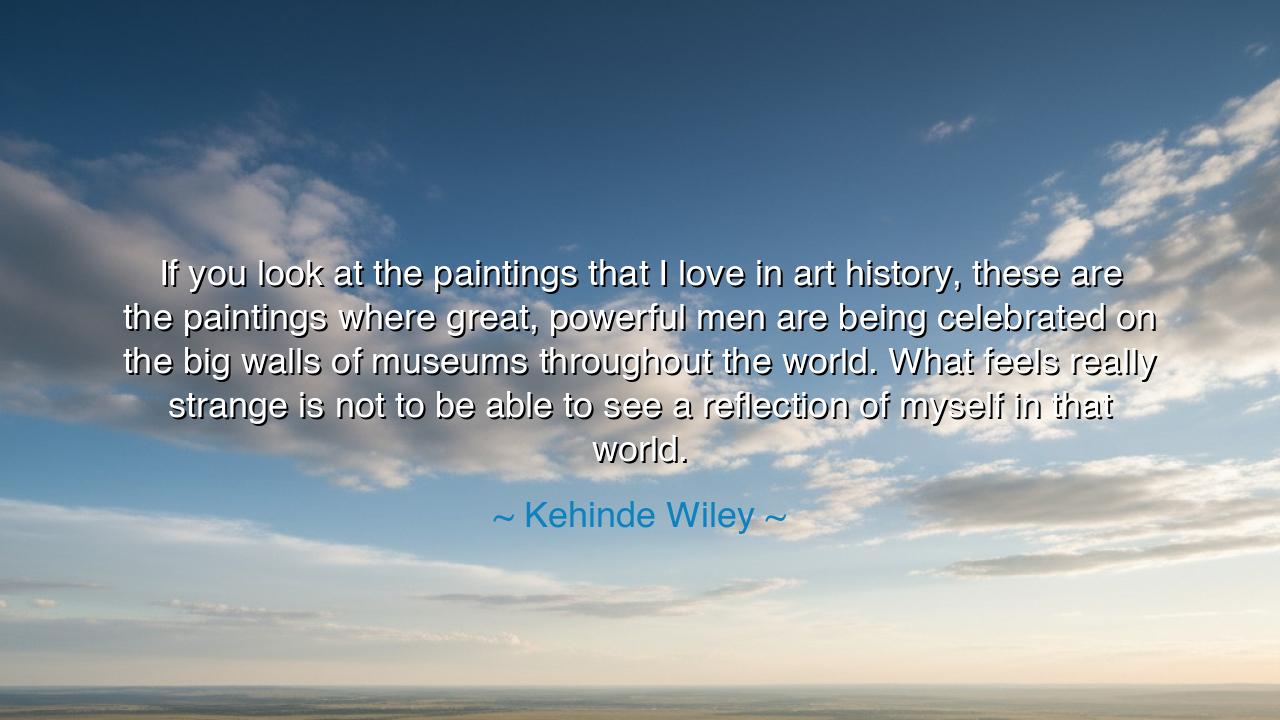
If you look at the paintings that I love in art history, these
If you look at the paintings that I love in art history, these are the paintings where great, powerful men are being celebrated on the big walls of museums throughout the world. What feels really strange is not to be able to see a reflection of myself in that world.






In a voice both contemplative and defiant, Kehinde Wiley, the visionary artist who reimagined the portraits of power, once said: “If you look at the paintings that I love in art history, these are the paintings where great, powerful men are being celebrated on the big walls of museums throughout the world. What feels really strange is not to be able to see a reflection of myself in that world.” These words rise like a lament and a declaration all at once—a lament for centuries of absence, and a declaration of return. In them lies not only the artist’s personal yearning but the collective cry of those long excluded from the grand narratives of beauty, power, and legacy. Wiley speaks here for every soul erased from the canvas of history, every face left in the shadows while others were immortalized in gold and oil.
To understand the origin of this quote, we must look to the life and art of Kehinde Wiley himself. Born in Los Angeles in 1977, he came of age surrounded by both the struggle and the resilience of Black America. As a young man, he studied the works of European masters—Titian, Velázquez, David—whose portraits of kings, generals, and nobles adorned the hallowed walls of great museums. These paintings celebrated power, dignity, and command, yet none of their subjects looked like him. The faces that stared back from those ornate frames were white, aristocratic, and male; they embodied the mythology of a world that had systematically excluded his ancestors. It was from this recognition, this ache of invisibility, that Wiley’s art was born. He took those same poses, those same compositions, and filled them with new life—with Black men and women, radiant in modern dress, asserting presence where there had once been silence.
When Wiley says it feels “strange not to see a reflection of myself,” he speaks to the profound power of representation. To see oneself mirrored in the art of a culture is to be told, “You belong.” To be absent is to be told, however subtly, that your story does not matter. The ancients understood this truth well: art was not merely decoration—it was memory. The pharaohs of Egypt carved their images in stone so that eternity would remember them. The emperors of Rome filled palaces with their likenesses to affirm their dominion over time. In every civilization, those who controlled art controlled narrative. Thus, when Wiley looks upon those grand portraits of European kings, he is not merely admiring their artistry—he is confronting the architecture of power itself, built to exclude people like him from its mythos.
His response, however, is not bitterness—it is creation. In painting everyday Black subjects in regal poses, Wiley performs what the ancients might have called an act of restoration. He reclaims the sacred ground of visibility, proclaiming that the descendants of those who were once enslaved, colonized, or silenced are no less worthy of grandeur, of reverence, of eternal recognition. In his works, the young Black man in streetwear becomes a heroic figure, adorned not in armor or royal robes, but in the fabrics of modern life. Behind him bloom floral backdrops—alive, defiant, almost divine. Here, Wiley rewrites the language of art, asserting that beauty and power are not the inheritance of the few, but the birthright of all.
History itself offers echoes of Wiley’s mission. In the Renaissance, when Artemisia Gentileschi painted herself into the roles of heroines and saints, she was doing what Wiley does now—reclaiming space in a world that denied her. In another age, the poet Phillis Wheatley, once enslaved, wielded language to carve a place for Black intellect in a culture that sought to erase it. And in our own time, Wiley’s greatest act of reclamation came when he painted President Barack Obama—a work that now hangs in the National Portrait Gallery, where once only white faces reigned. The circle, at last, began to close: the unseen had become the seen, the forgotten immortalized in color and form.
Yet, beyond art, Wiley’s reflection speaks to a universal human truth: all people seek to see themselves reflected in the story of their civilization. To be unseen is to be unanchored, to drift in the myth of another’s making. When a child enters a museum and sees no one who looks like them, they are taught—wordlessly—that greatness belongs to others. But when they see a face like theirs in the halls of history, something sacred ignites: the recognition that their story, too, is eternal. Wiley’s art, and his words, are a remedy to this erasure, a reminder that what we choose to remember defines who we are.
So let this be the teaching passed to you, O seeker of truth: do not accept invisibility as fate. If the walls of history do not reflect you, paint your own. If the stories of your people are not written, speak them into being. Celebrate yourself, your lineage, your culture—not in imitation of the past, but in conversation with it. As Kehinde Wiley teaches, the power to create one’s reflection is the power to reclaim one’s place in the world. And when every person can walk through the halls of art, of history, of memory, and see themselves shining back, then and only then will humanity’s portrait be complete.






AAdministratorAdministrator
Welcome, honored guests. Please leave a comment, we will respond soon